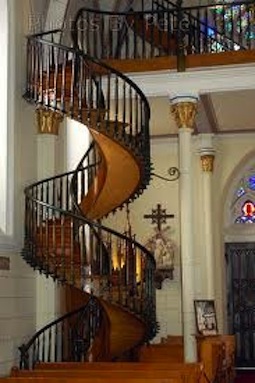I decided to take the southern route while driving across the country a couple years ago. I’d never been to Santa Fe, and wanted to get a glimpse of its historical riches – especially its mission churches, which predate the ones in California (from the 1770s) I have known from my youth.
Santa Fe’s old town square district is charming and lively. Only a few blocks away from the cathedral stands one of the oldest churches in the United States – the San Miguel chapel. Its huge wooden support beams, visible throughout the interior, are as indicative of its surroundings as its adobe walls, constructed in 1610. The distinctive devotional artwork within, deriving from Spain, also seizes the eye. Its compact earthiness, relative lack of height, and dearth of windows makes it reminiscent of the Romanesque.
Only a few steps away lies the chapel of Loretto, which, by contrast, looks transplanted directly from Europe. Built in the 1870s, its style is French Gothic. In fact, it was inspired after the Sainte Chapelle in Paris. Elegant in its own right from both the exterior and interior, its real claim to fame – as I was to discover only upon visiting – is its remarkable wooden, spiral staircase.

Here’s how it came to be. The recently arrived sisters of Loretto were pleased with the progress of the chapel – quite a sophisticated undertaking in such a remote corner of the new world – whose construction they had placed under the patronage of St. Joseph (whose feast day is tomorrow, by the way).
Only as construction was winding down did everyone realize that they had not devised a means for the nuns on the ground floor to access the choir loft above. They needed stairs of some sort, but given the height of the loft, a typical staircase would necessarily invade too much space below and seriously detract from its intimacy and integrity.
The sisters consulted with local carpenters, but none could provide a feasible proposal. They were in a bind. So they decided to pray a novena to St. Joseph. And on the ninth day, a man showed up on a donkey and offered to do the job. He had with him only a saw, a T-square, and a hammer. He worked alone. Accounts differ as to how long he took to complete the task, but it was likely at least several months.
The man solved the dilemma by creating a spiral staircase that made two complete 360 degree rotations. Typically such circular staircases require a vertical pole for support down the center, but he did it without one. He used no nails or screws – only wooden pegs as fasteners. At every step, the wood is perfectly curved. He’d soaked his wood in tubs of water the sisters had provided – but how exactly did he get all the curves just right?
Well, the net result, by all accounts, was a true masterpiece of craftsmanship and beauty –staggeringly produced with the most rudimentary instruments by a single, supremely skilled man.
When it was all finished, the ecstatic nuns went to pay the man. But they could not find him. He had simply left. They checked with the local lumber suppliers, thinking that at least they could pay for the wood. But they didn’t know what the sisters were talking about.
Speaking of the wood, the Mother Superior in 1960 reported: “Many experts have tried to identify the wood and where it came from. No one has ever been able to give a full report on it.” The one thing they knew by then was that this particular wood did not come from New Mexico.
Since then, a forester and wood specialist was given a sample of the wood, and spent over a year scientifically analyzing it. He produced a technical report, which I picked up in the gift shop. He was first able to determine that it was a cone-bearing evergreen, and later, a spruce. But what kind of spruce – which subspecies? Further molecular investigation revealed that it came from an extremely cold climate. This only confirmed it was definitely not local.
Ultimately, he could find no specific match in the scientific record for this particular type of wood. It has no known origin.

There are skeptics of this entire narrative, of course. But they have not provided an irrefutable explanation for this “miraculous staircase” – as it is commonly called. The subject of television movies and specials – even an “unsolved mystery” segment (none of which I’ve seen). It remains a source of fascination and wonder.
It’s hard not to notice that the carpenter left without saying a word, just as St. Joseph is silent throughout the Scriptures. Many feel that St. Joseph himself actually built it. The sisters and the entire local Church, however, were always properly reluctant to comment definitively – saying only that they knew it was somehow an answer to their prayers.
In her autobiography, St. Teresa of Avila could not have been more effusive in testifying to St. Joseph’s capacity for intercession; she obtained through him not only healing of temporary paralysis but also countless other and what she regarded as greater benefits for her soul. She regularly took to making requests of him on his feast day, which were granted without fail or at least, as she puts it, redirected for her greater good.
Having received blessings that far exceeded what she had asked of him, she wanted to convince everyone to be devoted to St. Joseph, imploring: “I only beg, for the love of God, that anyone who does not believe me will put what I say to the test.”
That inviting challenge remains before us, with all our needs and uncertainties, to be accepted.














